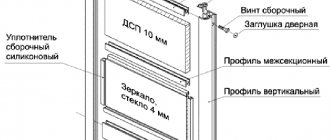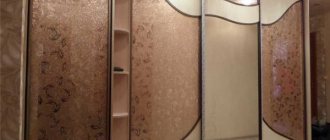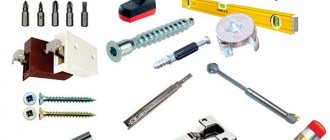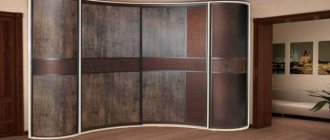How to disassemble a cabinet? Let's look at different types of structures and the features of their dismantling.
Are you moving or just planning a global reshuffle? It is better to carry cabinet furniture and transport it disassembled, because otherwise there is a high risk of damaging the facades, filling or fittings. Take the time to prepare: disassembling a wardrobe or wardrobe, and then recreating it in a new place is easier and faster than adjusting or completely changing hinges and guides.
The built-in storage system can also be relocated from place to place. Of course, provided that the new niche matches the previous one in size, and there are no problems with installation.
How to properly disassemble a cabinet? We tell you how to quickly and accurately dismantle cabinet and built-in models with your own hands and without the help of a professional technician, without damaging anything.
An important point: start working only after making sure that all shelves, hangers and mezzanines are completely free of things.
How to disassemble a wardrobe
How to disassemble a wardrobe? You will need a screwdriver, wrench, pliers and a set of screwdrivers, as some parts are easier to remove by hand. One person can cope with this problem, but it wouldn’t hurt to have a second one for backup: for example, it’s more convenient to clean the same doors with two people.
First of all, remove the sliding panels: lift them, move the lower wheels out. Secure it so that the doors do not damage the body or fall on you, and then carefully remove the supports from the upper guide bar.
Lay the canvases on the floor: there is still work to be done with them. For example, unscrew the stoppers and closers in the lower guide. Then you need to remove both guide bars, lower and upper. Unscrew the bottom and side roller mechanisms - this is where a screwdriver comes in handy.
Usually the canvases have a special duralumin frame, which adds strength and prevents damage to chipboard, MDF or mirrors - this also needs to be dismantled.
Important: if you are disassembling the coupe in order to put it back together soon, you do not need to unscrew the door closers or remove the trims and profiles. The main thing is to pack all structural elements so that they are not damaged during transportation.
Now you will need a wrench: use it to unscrew all the confirmats (blunt-tipped European screws with a countersunk head) and carefully remove the shelves. If the design involves the presence of a chest of drawers or drawers, remove them too: you need to bend the guide stopper and unscrew the screws. Don't be afraid to deform the metal elements: they are quite strong. The boxes themselves do not need to be disassembled; they “survive” transportation normally.
It is necessary to remove screws and other fasteners from the crossbar supports.
Now that the filling has been disassembled, let's move on to the body:
- Place the furniture on the floor; the side where the doors used to be should be at the bottom.
- Remove the screws and washers from the back wall. Proceed with caution: this part is usually made from fiberboard, which is easy to damage. Remove the connecting strip.
- Remove the confirmations from adjacent body panels and separate them.
- Using pliers, remove the dowels (cylindrical wooden rods). Try not to break them: replacing the dowel is easy, but to do this you will have to go to the store.
Be sure to sort the fittings and all fasteners into boxes or bags, labeling them accordingly. If you don't do this, it will be difficult to put the furniture back together. Shelves, panels and doors also need to be packed for future transportation.
How to disassemble a built-in wardrobe
How to disassemble a built-in wardrobe? It’s easier here: you only need to remove the filling and doors, because the role of the sides, bottom and lid is performed by the walls of a niche or room. You need to start by dismantling the doors. Remove the sliding panels in the same order as in the paragraph above.
The hinged ones must be removed from the racks in the opening, having first unscrewed the awnings. Remove shelves and drawers according to the algorithm described in the previous paragraph. And again, don’t forget about packaging the accessories and all components: sort them into separate packages and label them.
Do not forget that the installation is always adjusted in size: to the curvature of the floor, ceiling and walls. Dealing with dismantling the closet isn't everything: you may have to reorder shelves adjacent to the walls, partitions and floor-to-ceiling sides that were inserted at random.
We disassemble the swing wardrobe
For modern storage systems, the rules are essentially the same as for coupes. How to quickly disassemble a cabinet: start by dismantling the fronts, then remove the shelves. The fronts are easy to remove: on each hinge located on the side panel, just loosen 2 screws. Ready: the doors can be removed and packed away. Then proceed in the same way as in the case of sliding models.
You'll have to tinker with old-style cabinets. They were assembled a little differently: wooden dowels and even eccentric ties were used. To deal with shelves, handles and drawers you will need a set of screwdrivers, a screwdriver, a chisel and a rubber mallet.
First, remove the shelves that are not fixed in the cabinet, but simply rest on the holders. Then remove all the fastener plugs, corners and screws holding the other shelves and put them away. Using a screwdriver, unscrew the screws in the crossbar supports and remove them from the wardrobe. Now it’s the screwdriver’s turn: it is needed to remove the screws holding the body and mezzanines from the hinges. The removed doors can be laid on the floor and the handles unscrewed from them.
We remove the mezzanine
They can be attached:
- eccentric coupler;
- metal arc and screw.
An eccentric coupler is easier to disassemble. Insert a suitable screwdriver into the cross slot of the eccentric and carefully turn it counterclockwise. Then pry the cylinder with a flat-head screwdriver and pull it out. Done: all that remains is to separate the panels.
If the fastening is made in the form of a metal arc with a screw, which is also hidden in a cylindrical recess, you will have to tinker. You may need an awl or thick wire that will not bend under pressure. Insert the tip of an awl or the end of a wire into the screw hole, unscrew the pin, and then remove the bracket and separate the body parts.
Does not work? You can gently tap one of the plates with a rubber hammer so that the dowels come out of their sockets. Be patient and do not try to separate the elements using brute force: if the dowel breaks off, you will have to remove it from its socket, and this is inconvenient.
Wooden dowels can be removed with pliers, screws with a screwdriver. It remains to deal with the bottom of the mezzanine. Pry it with a chisel and move it a little to the side, and then remove it. You need to do this together!
We continue to disassemble the body on the floor:
- Use a chisel to pry up the back. In old cabinets, it is made of plywood and is attached to nails - they need to be removed using pliers.
- Remove the plywood itself and the connecting strip.
- Remove the remaining fasteners and remove the body panels.
An important nuance: if you have to dismantle a wall with glass doors, do this at the first stage, carefully releasing them from the hinge clamps.
Leg gluing and complete repair
The legs of a wooden chair can be glued with fresh glue that meets the specified characteristics. You should also stock up on a hammer with a rubber tip, sandpaper, a press and a chisel. Simple repairs are carried out in several stages:
- You should pull out the loose leg and clean the remaining old glue from the part where the product is loose.
- Fresh glue is applied to the leg, inserted back into the seat, and then sealed.
- It is necessary to place a press on the seat, remove the remaining glue and hold the parts to be glued for the time indicated on the glue packaging.
When asked how to glue a chair that has cracked in other places, you should first carefully disassemble the damaged parts. Repairing a chair with a drawer (frame connecting the legs of the chair) is considered difficult, since all the parts are glued and connected with a tenon groove. After disassembling the loose parts, it is necessary to clean the seams and apply glue to the joints. If the seam diverges, just drill a good hole and inject glue with a syringe.
If it is impossible to pull out the loose element, you should stretch the frame further and inject the adhesive into the groove. For strong stability, a narrow wedge can be inserted into the trunnion socket and secured with glue.
How to pack furniture for moving
How to disassemble a closet for moving? In order not to damage the case, internal filling, glass or mirror elements, it is important not only to carefully dismantle the product, but also to approach the packaging process correctly.
- Cover all panels and shelves with corrugated paper or cardboard so that there are no chips or abrasions on the laminate or enamel.
- It is best to lay glass and mirrors with foam. As a last resort, use bubble wrap.
- Shelves, cabinet parts and doors can be stacked to fit. Be sure to wrap the ends with corrugated cardboard or foam rubber, and pack each stack in film. It can be fixed with tape.
- Drawers and other elements from which you decide not to unscrew the fittings also need to be protected: it is better to wrap the corners, and if possible, line them with polystyrene foam.
- Store packages with accessories and fasteners in one box.
How to quickly disassemble and correctly reassemble a cabinet in another place?
Moving always involves transporting furniture. To avoid the inconvenience of moving and transporting cabinets, it is easier to disassemble them and then reassemble them in a new location. This procedure is also necessary when renovating a room. A modern wardrobe is easy to disassemble - the fasteners can be removed quickly. But furniture made during the Soviet era has outdated fittings and will require some skill.
Let's talk about the features of disassembling cabinet and built-in cabinets with your own hands. We will tell you how to pack disassembled furniture parts, as well as how to properly throw away an old wall with the least expense and in accordance with the law.
How to disassemble an old Soviet cabinet?
Wardrobes of the 70s and later periods of the last century were assembled mainly on eccentric ties, wooden dowels and screws. If you need disassembly and subsequent reassembly for moving, follow the instructions:
Stage No. 1: Shelves, drawers, handles
- Prepare the tools: rubber hammer, set of screwdrivers, screwdriver, chisel.
- Clear the floor near the cabinet so that it can be placed.
- Remove the shelves that rest loosely on the shelf supports.
We take out removable shelves first - Remove the fixed fasteners from the other shelves and remove them.
- Pull out the drawers.
- Use a screwdriver to unscrew the screws of the crossbar supports. Take all this out of the wardrobe.
- Using a screwdriver, unscrew the hinge screws on the doors of the building and mezzanine.
- Remove the cabinet fronts and place them carefully to the side.
- Unscrew the door handles.
- Inspect the mezzanine fasteners from the inside at the top of the cabinet body.
- Remove the plastic covers from the mounting sockets.
Stage No. 2: Fasteners and mezzanine
Depending on the type of fasteners, remove them with the appropriate tool:
- The connection on the eccentric coupler is dismantled by turning a screwdriver inserted into the cross slot of the eccentric counterclockwise.
The cylinder is removed by prying it off with a flat screwdriver. You can then quickly separate adjacent panels of the cabinet body. An eccentric coupler is the most popular type of furniture connection. - Disassemble the fastening in the form of a metal arc and a screw inserted into its slot, placed in a cylindrical recess of the panel, using an awl or a piece of thick wire. Insert the point into the hole of the screw and unscrew the pin. Remove the bracket and separate the panels.
- If they do not come apart when pressed with a chisel, tap one of the plates with a rubber hammer. The dowels will come out of their nests. Gently grab the pliers and pull out the wooden dowels;
- Remove the screws from the metal sockets. If the thread does not give way, loosen it with pliers.
- Using a wide chisel, pry the bottom of the mezzanine box, separating it from the cabinet lid, and slightly move the mezzanine to the side. It takes two people to remove it, especially if it is a 3-door wardrobe.
- Carefully lower the housing, freed from filling elements, with its front part on the floor.
Stage No. 3: Back wall, hinges, frame
- Use a chisel to pry up the plywood back wall and lift up the nails. Press the wall back down and remove the nails with pliers.
- Remove the plywood and the connecting strip, if any.
- Remove the fasteners in three corners of the box. Remove the released panels.
- Now disassemble the remaining fastening.
- Place the bottom with the support frame facing up. Remove the frame by unscrewing the screws.
- Also disassemble the mezzanine.
- In the Soviet wall, carefully remove the glass doors, freeing them from the hinge clamps. Then remove the loops from their sockets.
- All of the above also applies to Estonian-assembled furniture.
During disassembly, place the removed accessories in bags. Include sheets of paper with marks of parts belonging to them.
Disassemble the corner cabinet without changing the position of the cabinet. Due to geometric features, such furniture is stable and does not need to be tipped over to the floor.
Preparatory stages
- Take out the mirrors and pack them separately. Remove wooden shelves if it is not possible to attach them well to the walls.
- When dismantling, you should sign where each part comes from. Stickers (“right door”, “bottom”, “top board”) will help out; place the sheets under the tape.
- Collect the fastening material for each product in a separate package and secure it to a suitable furniture component.
- Remove the handles in order to place the transported items more tightly, the furniture sways less during transportation, or twist them by placing them inside the item.
Work order
Actions - from small to large, from shelves to partitions, sides. The cargo is packed using paper, stretch film, tape, cardboard, and air bubble film. Upholstered furniture is covered with film. Before transportation, the armrests and sides of the sofa book are removed. The pull-out sofa (chair) is disassembled into parts, highlighting the transforming component.
Leather furniture cannot be transported in cold weather. The material bursts due to prolonged exposure to cold air. If transportation in winter is unavoidable, then the leather upholstery should be carefully wrapped in blankets; the period of stay in outdoor conditions should be minimal. After bringing such a product into the house, it should not be opened immediately. Let it sit for a couple of hours: there will be no sudden temperature changes.
The main types of fittings for fastening shelves, methods of disassembly
- turning the cross of four eccentrics under the shelf in a counterclockwise direction will loosen the fastener; it can be removed by lifting it up;
- if Euroscrews (confirmations) are used, then they are unscrewed with a hexagon from the end of the shelf on the opposite side of the sidewall;
- built-in furniture is assembled on mounting angles; screws are unscrewed to disconnect;
- The product, supported by metal eccentrics (minifixes), can be completely disassembled; simply removing the shelf will not work.
With standard furniture, everything is intuitive; even a beginner can handle the task of disassembling. When dismantling a designer structure, you need your own set of tools and the ability to read the diagram correctly. It's not easy for everyone to figure it out. Nuances must be taken into account, including the characteristics of fastening elements and materials of manufacture. It is difficult to disassemble and reassemble objects that have been subjected to similar manipulations many times.
How to disassemble a wardrobe?
Before you begin disassembling a wardrobe with sliding doors:
- prepare packaging material for transporting disassembled furniture. These are bubble or simple polyethylene film, PSBS (foam plastic), corrugated cardboard, foam rubber and tape. Make room for disassembling the wardrobe body in a horizontal position;
- drag the cabinet into a spacious room if it is located in a narrow corridor. To avoid damaging the surface of the floor covering, place an old sheet or other material under the furniture supports. Pushing the body from the side, pull the material of the cabinet in the desired direction;
- you can use the old method of moving furniture: place potato halves under the legs, cut side down - the cabinet will easily “move”;
- After the preparatory work, proceed to disassembly.
Expert opinion
Alexander Didenko
Furniture assembler at Mabaks
If you will be assembling furniture in a new place yourself and there are no factory instructions, so as not to forget anything, first draw a plan, mark the order of disassembly on it with numbers and apply the same numbering to the parts with a washable (alcohol) marker, a construction pencil or stick stickers . You can also take pictures of the entire process and details on your phone.
Step-by-step instructions for disassembling a wardrobe
- Remove the sliding doors. Push the curtains up and move the lower door wheels out. Remove the supports from the top guide bar.
- Place the doors separately on the floor.
- Using a screwdriver, unscrew the stoppers and closers in the lower guide rail.
- Remove the upper and lower guide bars.
- Unscrew the bottom and side roller mechanisms with a screwdriver.
- Remove the duralumin frame of the door panels (horizontal and side profiles).
- If you have to reassemble the wardrobe, you do not need to follow steps 3 - 6.
- Using a wrench, remove the confirmations and remove the shelves.
- Also empty the interior cabinet of drawers.
To do this, unscrew the screws of the ball guides. To remove the drawers, bend the guide stopper - Remove the screws in the crossbar supports and remove all parts.
- Place the cabinet body face down on the floor. Pre-cover the floor with film or a piece of fabric.
- Remove the screws and washers on the back wall of the fiberboard. Remove the cardboard sheets and the connecting strip.
- Separate the two adjacent panels of the case by unscrewing the confirmations. Then detach the other two adjacent planes.
- Use pliers to remove the dowels from their sockets.
- Sort the fittings and fasteners into bags with appropriate labels.
- Pack panels, shelves, doors. Now you can transport the disassembled cabinet.
Expert opinion
Alexander Didenko
Furniture assembler at Mabaks
Dismantling kitchen furniture also begins with dismantling the facades. Boxes of cabinets and cabinets can be connected using glue and dowels. A chisel and a rubber mallet are suitable for this work.
Dismantling a built-in wardrobe concerns only the filling and doors (sliding or hinged design). Dismantle the compartment facades in the same order as in the previous case. Remove swing doors from the vertical posts of the opening by unscrewing the awnings. Dismantle and remove the cabinet filling in the same sequence as when disassembling the wardrobe. Now all that remains is to pack all the pieces of furniture for moving or move them to another room in case of renovation.
Creating a stylish interior with your own hands
Does your grandmother carefully preserve furniture purchased many decades ago? At the moment, Soviet furniture in a modern interior looks quite stylish, you just need to show a little imagination.
- Using a Soviet carpet in a modern interior
- Transforming the Soviet wall into a modern way
- The use of Soviet crystal in a modern interior
- Soviet sofa in a modern interior
- Antique chests of drawers in a modern interior
- Advantages of using Soviet furniture in a modern interior
- Planning an interior design in an antique style
- Transformation of Soviet furniture with the help of a designer
- Economical interior update
- Photo gallery - Soviet furniture in a modern interior
- Video
You can use existing furniture as a basis to create real masterpieces. The following items will provide excellent solutions:
- An old carpet, red was once in fashion.
- A wall that runs along the entire length of the wall.
- Sofas that were previously very difficult to buy.
- A variety of chests of drawers and sideboards.
- Soviet crystal, which was taken out only on major holidays.
You can make real masterpieces from old Soviet furniture
You can give new life to old things. Such a transformation will bring great joy to grandparents, who will be able to feel your attention and care.
Using a Soviet carpet in a modern interior
Carpets purchased in Soviet times are of high quality. They are made of wool, so they are ready to give warmth and comfort. As a rule, such an element was rarely located on the floor.
In ancient times, the carpet was treated very carefully; it hung on the wall. Currently you can use this masterpiece in the following interpretations:
- Bedroom decoration. It can be placed under the bed, protruding slightly beyond it. The result will be a luxurious podium built in oriental style.
Old Soviet carpet in a modern interior
- Living room decoration. An excellent solution would be cut carpet elements, which are made in the form of covers for armchairs and sofas. If you also cut squares that can be placed on the floor, you can enjoy the warmth and coziness.
Sofa covers from Kovar
- It is wonderful to use natural carpets to decorate a children's room. You need to cut the old carpet into specific pieces that can be placed near the child’s bed, in the play corner. Your baby will be able to enjoy the warmth, and natural wool is good for health.
Excellent solutions will come from decorative elements made from carpet remnants. You can make covers for chairs and stools. It is enough to use individual squares, which will become a wonderful decoration for kitchen furniture.
The whole carpet looks very colorful, but if you cut it into squares, you will get a stylish solution that looks very fashionable and harmonious. You can create an individual style that emphasizes your taste and sophistication.
Transforming the Soviet wall into a modern way
If you have an old Soviet wall, then it needs to be updated a little. The main advantage of such furniture is its spaciousness, so you shouldn’t throw away the rarity.
How much does a cabinet removal service cost?
If you are unable to disassemble the wardrobe yourself, use the services of specialists. Depending on the region of the country, one employee charges 350 - 400 rubles per hour for this. On average, disassembling a cabinet takes 1.5 to 2 hours. See the table for an example of prices from Domovit-Service Group of Companies.
Additional gluing points
Experts recommend thoroughly cleaning the connecting areas, which are subsequently glued together. If the old glue is difficult to scrape off, apply warm vinegar or solvent to the cleaning area.
To securely secure the structure, many craftsmen, after gluing the parts, use a tension belt or clamp to press tightly and dry quickly.
If, after repairing the structure, creaks and other problems remain, and the seals did not help, it is advisable to use the services of professionals and contact a workshop for help.
How to pack a disassembled wardrobe for moving?
For high-quality packaging you will need sheets of cardboard, film for painting, tape, foam rubber or polystyrene foam. You can pick up empty used boxes from any store for free. So let's get started:
- Cover all panels and shelves with corrugated cardboard to prevent abrasions on the laminated surface of furniture parts during transportation.
- Fold long slabs first, then smaller panels.
- Cover glass or mirror sheets with bubble polyethylene film or foam strips.
- Wrap all stacks with two layers of covering polymer film for painting work. Pre-wrap the ends with foam rubber or corrugated cardboard.
- Secure the plastic cover with tape along both the length and width of the panels.
- Wrap drawers and cabinet bodies with film with foam or foam padding at the corners.
- Place bags of accessories in one box.
- Do the same with packing the back walls.
- Now, all this can be taken out and put into transport.
Foamed polyethylene and corrugated cardboard
Main types of adhesives and their characteristics
- PVA: no toxicity, fast acting, unlimited shelf life.
PVA glue is in demand in the furniture industry, the manufacture of interior items, and, if necessary, to join any wooden parts.
Epoxy glue has become massively popular because it firmly bonds almost all materials and perfectly levels the surface.
BF-2 glue is suitable for gluing wood; it has an optimal range of qualities - it is not susceptible to fungus, oils, gasoline, and is waterproof.
Syndeticone glue is excellent for gluing wood and gluing various materials to it.
Polyurethane waterproof wood adhesive is considered the most resistant to stress and vibration.
How to properly throw out a closet?
If the furniture is so decrepit that you decide to throw away the cabinet, then there are two options:
- Take out the entire wardrobe.
- Disassemble the cabinet for disposal.
Take out the entire wardrobe
You can move the cabinet without disassembling it by renting two lifting belts and inviting an assistant. That's what movers do. Carrying bulky furniture using belts is not particularly difficult. The technology can be mastered in a short time. If your home has a freight elevator, this will make the task much easier.
You can’t just put old furniture near the entrance or trash can. There is a specially designated place for bulky waste in each locality. Usually this is a solid waste landfill or simply a landfill. Residents of private houses were luckier. Burning waste in your own fenced area is not prohibited.
Disassemble the cabinet for disposal
In this case, arm yourself with a pry bar and a hammer. You can tear the doors out of their hinges by pressing them away from the body with a mounting spatula. Insert a pry bar into the cracks and separate the panels. Using a hammer and spatula, remove the filling elements. Collect everything disassembled into bags and take it to the garbage container site. Make sure this is not prohibited by your building code. Otherwise, use a waste removal service.
The management company is responsible for the removal of large-sized rubbish.











